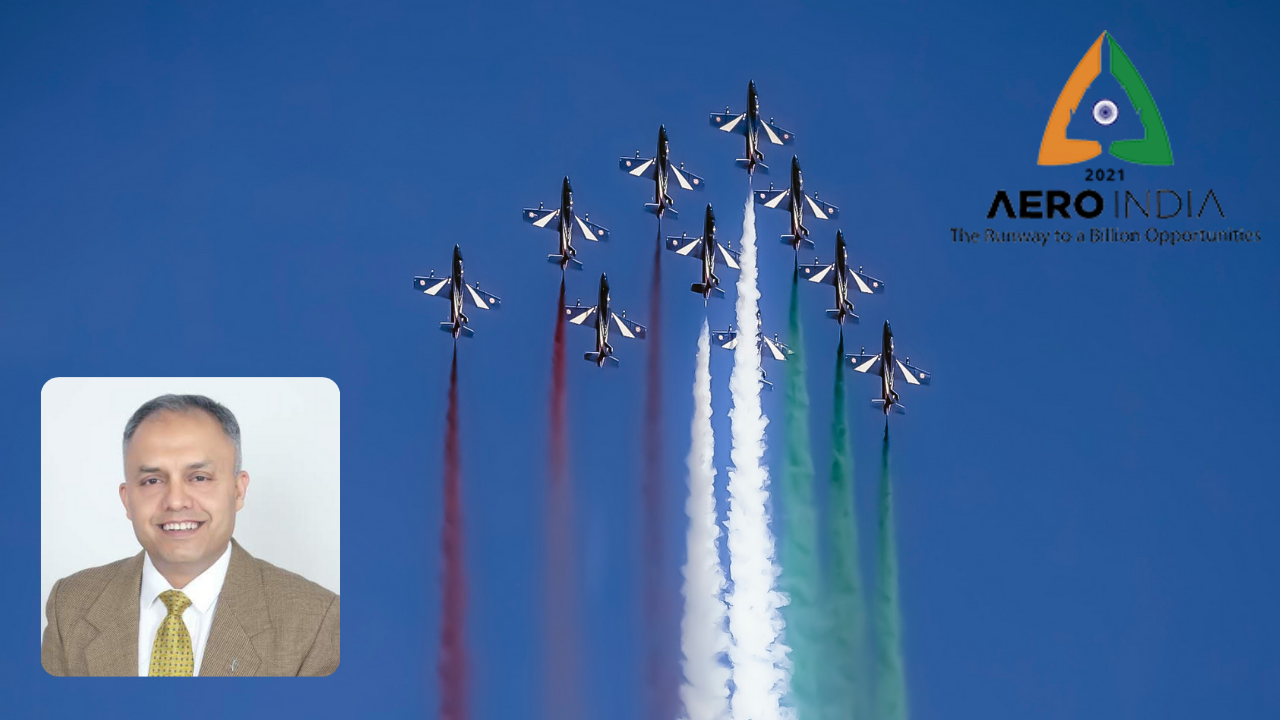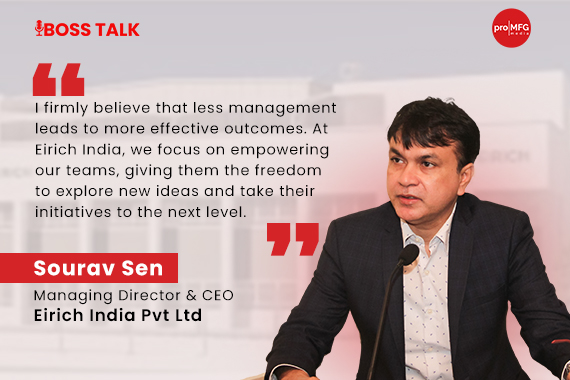India’s Aerospace & Defense Manufacturing – Vision ‘Atmanirbhar’ – Part 2
#Aerospace #Leadership #DefenceWing Commander Arun Kumar is an IAF Veteran with more than 28 years Program, Procurement, People & Operations Management experience in the domains of Aerospace, Defense & Technology (Command & Control IT Frameworks for Disaster Management & Smart Cities, IoT Frameworks for Power Management). Besides having done his MBA- B.Tech from IIFT & NIT Bhopal resp., he is a certified PMP-Six Sigma professional from PMI, US and Indian Statistical Institute, resp.

GLOBAL AEROSPACE INDUSTRY
The aerospace industry accounts for nearly 40% of global military expenditure which stood at around $1,850 billion last year. US is a major player in terms of military expenditure (30%), export of conventional arms (34%) and allocation to defense R&D (60%). Nearly two-thirds of major defense OEMs are based out of the US. India is literally the largest importer of arms, having a humongous share of global defense imports, making it a favored hunting ground for OEMs of countries such as Russia, USA, France, UK, and Israel.
The aerospace industry is a major player involved in the development, production and maintenance of aircraft, missiles, and UAVs. It also includes airborne defense electronics, simulation, ground supply engineering and Maintenance, Repair and Overhaul (MRO). The aircraft systems and component manufacturers account for 26%, civil and military MRO – 27%, aircraft and engines (28%), while satellites, missiles, and UAV account for around 7% each in aerospace manufacturing. The US is a predominant player in aerospace manufacturing accounting for nearly 50% of around $838 billion.
INDIAN A&D INDUSTRY STRUCTURE
The Indian industry structure can be broadly classified into following areas:
- Commercial Airlines & Air Services Operators: Offering passenger and cargo services and procuring airplanes, helicopters etc. from global companies like Boeing, Airbus, Sikorsky etc. India operates fewer than 300 civilian helicopters compared to over 14,000 in the United States. Similarly, India has few small fixed-wing aircraft.
- MOD and Other Govt Entities: For purchasing aircraft and other equipment for defense and other requirements.
- Aircraft / Airplane, Helicopter, Space Equipment Manufacturers: OEMs largely restricted to PSUs like HAL, NAL, ISRO and other Govt entities. India’s nascent Helicopter Emergency Medical Services (HEMS) sector holds large potential for global service providers. The increasing urbanization of Indian cities, marked by rapid growth and high traffic density, makes the need for HEMS even more urgent.
- Ancillary Manufacturers of Aerospace Components & Assemblies: Various types of metallic, non-metallic, and composite parts for engines, aero structures, airplane interiors, space programs etc. for both domestic supply and exports to international manufacturers.
- MRO and Other Service Operators: India continues to try to develop the MRO sector. For maintenance and repair services for airplanes and other aircrafts. India’s growing fleet of airplanes will demand more maintenance services. 90% of India’s MRO business currently occurs outside India, especially in Sri Lanka, Singapore, and Malaysia. India’s GST (Goods and Services Tax) Council has decided to re-work the GST structure for MRO for aircraft, slashing the tax from 18% to 5% along with providing the benefit of full tax credit on inputs.
- Human Resource Development: Training, skilling, and human resource development is another Govt and industry priority. The supply of skilled human resources has not kept pace with the aviation industry’s rapid growth. There are opportunities for education and training service providers in all aspects of the aviation industry.
- Remotely Piloted Aircraft (RPA) And Drones: India sees great potential and aims to develop opportunities for drones and remote aircraft. Recently, the DGCA allowed ten consortia to carry out “Beyond Visual Line Of Sight” (BVLOS) drone projects in designated airspaces across the country.
MARKET SIZE
The Indian aerospace industry is already one of its fastest growing sectors, expected to become the 3rd largest aerospace industry globally by 2024-25, having entered the category of large commercial and defense aircraft market, clubbed with its rising passenger traffic, and increasing defense expenditure budget allocations, the demand for aircraft, its Support Infrastructure, Support Services and Support Teams in India, notwithstanding the temporary Pandemic created economic environment.
From a single carrier, Air India / Indian Airlines until the 1990s, today there are strong private airlines like Indigo, Spice, Go Air, Vistara, Air Asia etc. which are competing for a share in the ever-growing market pie, giving rise to unprecedented demand for new airplanes with many airlines placing large orders for airplanes over the coming years to meet the growing needs of the domestic and international Indian traveler. There is large growth for smaller aircraft, business jets, helicopters etc. for regional connectivity based on the Indian Govt’s RCS (Regional Connectivity Scheme) under UDAN and faster movement as the demand from business and other travelers increases with economic growth.
AVIATION MARKET GROWTH
Globally, the commercial aircraft fleets are expected to grow at a CAGR of 4% during the period up to 2035. Boeing has forecasted a need for over 30,000 aircraft to be added during this period, with approximately 38% deliveries to airlines in the Asian region. Airbus has forecast a demand for 25,500 new aircraft deliveries during the same period. On an average, around 42% of the demand will be for replacement of the existing aircrafts and 58% will be the incremental growth. Single-aisle airplanes will dominate the world’s fleet with around 71% share of new deliveries during this period. A majority of these deliveries will be around Asia-pacific region – with India, China, South East Asia and the Middle East being key markets for the global aircraft majors.
DEFENCE SECTOR
India’s defense expenditure has increased at a CAGR of around 10% from 2008-16, reaching current levels of USD 63.51 bn. The cumulative capital budget between the 12th-14th 5-Yr plan (2012-2027) for the Indian Air Force (IAF) is projected at approx. US $218 billion, of which 69% is for acquisition of aircrafts and aero engines. IAF is estimated to spend close to US $150 billion on Aircraft and Aeroengine in the next 15 years, with spending expected to grow by 10-15% PA, indicating a large pipeline of orders in the military aircraft segment and growing need for Indian sourcing partners.
DEVELOPMENTS IN A&D INDUSTRY
Prior to 2001, A&D industries were exclusively reserved for PSUs, with the latter consequently growing tremendously by developing and acquiring new technologies and entering the manufacture of indigenous aircraft. Over the years, these PSUs have also helped a number of industries (large and small) to acquire technologies, technical and managerial processes, better quality standards, infrastructure and facilities, networking etc. In addition, several private sector groups such as Tata, L&T, Mahindra, Kirloskar, Godrej and a large number of smaller companies have been supplying limited parts and equipment to the Defense Forces and PSUs as Tier-1 Suppliers.
The private sector does not have any independent production complex. However, after liberalization in the defense sector in 2001, allowing FDI of 26%, and subsequently raising it up to 49%, private companies such as TASL, Mahindra, Kirloskar, Godrej, L&T have entered into collaborative arrangement with foreign Aircraft, Helicopter, Engine, Assembly OEMs for the production of parts / components / sub-assemblies in their global supply chains for their end products. Their association with HAL is more as sub-contractors rather than as partners. FDI at 100% is allowed for civil aviation infrastructure, while any airline stake, greater than 49%, however, and requires Govt approval.
Leading global OEMs have established JVs in India for the manufacturing of aero¬space related parts and assemblies which find their way into many commercial and defense aircraft and helicopters. The sector has seen adoption of best practices and maintains international standards in quality for components but India as a country has yet to address the need to develop more facilities that provide end-to-end aerospace solutions.
The major policies have been driven by the Kelkar Committee and Make-in-India initiative. The Kelker Committee advocated a level playing field for the private sector and encouraged PPP in the defence sector. It also kick-started the ‘offset policy’, introduced in the DPP in 2009, which sought to capitalize on India’s \big-ticket acquisition by asking OEMs to part with key technology, bring in FDI and outsource production requirements.
Make-in-India has been a major initiative of the GoI to improve its manufacturing footprint from its share of 16% in GDP to about 25%. Of the 25 sectors identified, aviation is a major sector. The Dhirendra Singh Committee (2016) suggested a strategic partnership between major public and private sector players. However, this has not made any discernible impact.
ISSUES WITH PSUs & STATE ENTERPRISES
Although HAL’s vision is to ‘become a significant global player in the aerospace industry’ with a mission to achieve self reliance in design and development, upgrade and maintenance of aerospace equipment with world-class performance standards, value addition and growth in exports and it has improved its performance significantly from 35% to about 60% over the decade (2009-19), however, in terms of allocation to R&D, it is quite meagre compared to major global aerospace companies, who spend more than 10%. Moreover, HAL has also not been able to make any further impact after its success in selling a few ALHs to Peru and Ecuador. The long delay in designing and developing the LUH has become a veritable justification for the services to clamour for import. The same story applies to the design of a basic trainer aircraft.
However, the weaknesses are the absence of established OEMs, protectionism extended to the HAL as a captive supplier, lack of Tier-II and Tier-III companies that can support aircraft manufacturers and SMEs struggling to go up the value chain. A major hiccup has been the cancellation of the TOT agreement between M/s. Dassault Aviation and HAL for the manufacturing of the MMRCA aircraft in India. The change from ‘Buy & Make’ to ‘Buy’ from Dassault Aviation has been a major setback for Make-in-India initiatives.
Entities such as HAL, DRDO, NAL, MIDHANI, ADA and Indian Institute of Science, Bangalore have often been seen to be working in silos. In Russia, the design and the production houses work under one umbrella. The Rama Rao committee had very strongly suggested that design, development, and production should be under the supervision of the one agency. This will bring in better coordination and accountability. The committee had pointed out how the failure of the Kaveri Engine was due to the lack of synergy between GTRE (the design lab) and HAL (the production agency).
There is conspicuous lack of synergy between the private sector players and HAL, with the former perceiving HAL and the likes as adversaries rather than collaborators. The private sector players have a legitimate grievance that they are deprived of the technology from foreign companies and often bereft of Govt support. The fallout of this has been enormous delay, high costs and the lack of accountability by an aerospace major such as HAL.
OPPORTUNITIES
The Pandemic is bound to have a deep impact on what was previously a fast-growing sector. The industry needs, and is currently undergoing, major restructuring to meet the challenges ahead. Business models, traffic growth, fleet expansion, pricing, and costs may have to be made contextually relevant.
As India builds Greenfield and Brownfield airports over the next 10 years, policy reforms such as the inclusion of ATF (Aviation Turbine Fuel) in the Goods and Services Tax (GST) would create opportunities for U.S. companies to address India’s shortage of Maintenance Repair Operations (MRO) facilities. Boeing, Airbus, and other leading OEMs consider India an important global market to fulfill needs for Tier-1 suppliers and set up an aerospace industry ecosystem within the country.
India’s MRO (Maintenance, Repair and Overhaul) segment is estimated to grow at 10% and expected to reach USD 2.6 billion by 2021. India’s DGCA approved Aircraft Maintenance Organization (AMO) / Maintenance Repair and Overhaul (MRO) list already has 50 Standalone AMO/MRO and 69 Operator & AMO/ MRO service providers.
About 70% of the defence requirements are met through imports, accounting for a major portion of defence-related requirements, which offers a huge opportunity for foreign investors. In the coming years, Govt targets to step up local sourcing to reduce the defence budget by a significant number. GoI is currently pursuing the goal of having a turnover of 25.5 billion USD in military goods and services by 2025.
With the global business sentiment in China – presently one of the largest exporters of aircraft components – weakening, India’s future as a manufacturer of higher-complexity aerospace items is completely in our hands. The opportunity is now for India to present itself as a viable alternative to China's sourcing before the World.
NEWSLETTER
TRENDING ON PRO MFG
MORE FROM THE SECTION




.jpg)




